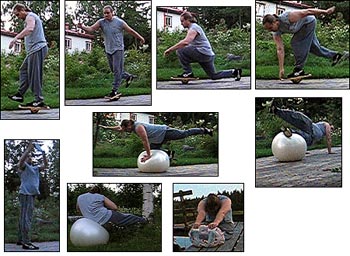Archives for rehab (page 2)
September 4, 2004
Theracaning myself
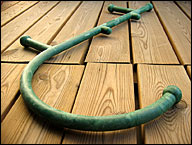 Started poking around in the adductor area with Sanna’s Thera cane on Friday as the inner thigh pain did not diminish at all, even with copious amounts of muscle relaxants and pain killers. Found two v-e-r-y tender spots close to the groin in what must be the adductor longus and adductor brevis. The Trigger Point Therapy Workbook confirms that adductor longus trigger points tend to make the inner thigh feel drawn up causing restricted movement in all directions. The book also warns that local trigger points form easily when these muscles are overstretched, such as when taking inordinately long steps.
Started poking around in the adductor area with Sanna’s Thera cane on Friday as the inner thigh pain did not diminish at all, even with copious amounts of muscle relaxants and pain killers. Found two v-e-r-y tender spots close to the groin in what must be the adductor longus and adductor brevis. The Trigger Point Therapy Workbook confirms that adductor longus trigger points tend to make the inner thigh feel drawn up causing restricted movement in all directions. The book also warns that local trigger points form easily when these muscles are overstretched, such as when taking inordinately long steps.
My amateur conjecture is that my tender spots developed on Monday as a result of walking around for most of the day in an unnatural walking style caused by the cramp in my lower back. This seems consistent with the fact that the pain developed gradually towards the end of the day. Aggressive trigger point massage of these areas do seem to help and standing now causes much less agony.
There is also a spot about two-thirds up on the lower leg (outer side of gastrocnemius) that is nagging me. Cane cane cane, cane away the pain… hope it works. I have no idea what will happen, but my mantra remains “Mobile by Monday”. To that end, I’ve also begun doing light static stretching.
August 31, 2004
Bummer.
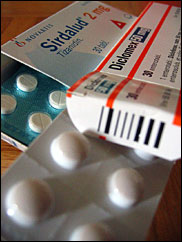 The accumulated stress of first reintroducing box squats and deadlifts and then proceeding with the normal program, including weighted hypers and Bradford presses, ended up being too much after all. I’m now twisted again as in drooping right shoulder as in lumbago.
The accumulated stress of first reintroducing box squats and deadlifts and then proceeding with the normal program, including weighted hypers and Bradford presses, ended up being too much after all. I’m now twisted again as in drooping right shoulder as in lumbago.
The Reaper came on Saturday. I had just had a refreshing swim in the dark n’ chilly August water and was standing outside watching the fireworks that, paradoxically enough, celebrated the end of the Finnish summer cottage season. Stiffness gradually turned into pain and I had to make a limping retreat inside to lay down. Next morning, the cramp was still with me. A liberal amount of pain killers made the six hour car ride back to Helsinki quite tolerable sorry mood notwithstanding.
Monday morning was much the same, but felt obliged to go to work to wrap some things up including returning the big pile of math books that I had corrected over the weekend (23 books + 1 crooked back = a lot of trouble). I ended up teaching all classes and planned the rest of the week for a possible stand-in before finally heading for the doctor. By this time, the adductors on the inside of my left thigh had also started to tighten up, possibly from all the running around.
At the doctor’s I knew the drill. Tell story, have knees and ankles hammered, bend over and confirm that you can feel your feet. On the bending over part I surprised both myself and the doctor with almost being able to touch the floor despite the cramp. I also knew what I would get, i.e. a prescription for tizanidine and diclofenac to deal with the cramp and some sick leave (rest of the week) to prevent me from doing any more potentially hazardous math equations. I asked the doctor’s opinion on taking a MRI scan of my back. She said that since everything, luckily, points to a muscle condition and not a disc condition this would amount to a waste of my money. She also expressed high regard for the expertise at the back clinic and continued that relapses are quite common when dealing with something as complex as a back injury. After the appointment I went to the bookstore to pick up another Vonnegut, this time Palm Sunday, and then headed for the pharmacy. The adductors were starting to make life difficult for me and I was thankful the bus had been invented. Home.
This morning I was straight again, but as I prepared my breakfast the back cramp kicked back in. The adductors also keep defying the muscle relaxants by going into a painful cramp whenever I stand or walk for more than a minute. Can’t even do the banana, but interestingly enough I don’t really feel that I need it. The back is no longer painful, but the adductors are.
Adductors, adductors. Why would they cramp? Somewhat grudgingly I have to admit that for some time I haven’t been able to sit down on the floor and open my legs more than 90 degrees. I remember the days when I could spread them out a full 180 and then put my chest on the floor. Tightness is definitively a prime suspect. And what am I going to do about that? Stretch, stretch.
I found an interesting article by Chris Mallac that discusses how overuse of the adductor magnus may lead to trigger point development within the muscle. His first case study deals with a powerlifter with a six-month history of left-sided lower back pain. The patient had, like me, also done exercises for the core stabilizers and had also had cortisone injections to no avail. A month after trigger point massage of the adductors began this lifter was back on track on both the deadlift and the squat. It is interesting to read that the author has found the large majority of adductor magnus problems to be left-sided, which would also be true in my case if it turns out I have trigger points there.
All in all, I don’t think this relapse really necessitates a fundamental rethinking of my rehab approach. The increased mobility and lower amount of stiffness is a sign that progress has taken place, but I definitively need to reconsider my squat and deadlift schedule. I also need to take stretching more seriously and liberate my legs. Two steps forward, one step back, I suppose. Good thing I can bench.
August 22, 2004
A light return to box squats and deadlifts
 The time is ripe to begin the climb back up to some real squat/deadlift workouts. Since I will be making the return very gradually, starting with ridiculously small weights, it feels natural to do both the box squats and the deadlifts as speed work on DE Squat/Dead day.
The time is ripe to begin the climb back up to some real squat/deadlift workouts. Since I will be making the return very gradually, starting with ridiculously small weights, it feels natural to do both the box squats and the deadlifts as speed work on DE Squat/Dead day.
An empty bar felt needlessly light, so worked with a safe sounding 40 kg/88 lbs on both exercises. My master plan is to increase the weight on the box squat and the deadlift with 2.5 kg/6 lbs per week. This scheme would have me increase the weight by 10 kg/22 lbs a month meaning I would be up to some meaningful speed box squat poundages by the end of the year. This timetable corresponds fairly well with my back therapist’s assessment regarding my discs being back in shape by the end of the year. I might speed things up a bit later if there are no complications, especially for the deadlift, but for now I start with this conservative base plan.
I don’t plan to do much supplementary work on DE SQ/DL day save for some ab work, but will continue doing a heavy dose of rehab work. The action will be on ME SQ/DL day where I will continue doing exercises that I can go to failure with for reps, i.e. GHRs, makeshift reverse hypers and such. Once the weights start to climb on DE day, I will slowly start to do light pin pulls etc. as supplementary work. Squats without a box will also start to figure in this context a bit later once I’ve made sure that my back can handle the reversal without locking up.
No complaints from the back today, but noticed that it had tightened up a bit when I did hanging leg raises following the box squat and deadlift. Deep down I still fear that I might have something structurally broken in my back, but at this point I cannot do much more than go on with the plan and if I get into trouble head for a magnetic scan. For now, I am glad to be back squatting and deadlifting even if it is with puny weights.
Speed box squat, 13″:
3x5 @ 20 kg/44 lbs
3x2 @ 30 kg/66 lbs
6x2 @ 40 kg/88 lbs
Speed deadlift:
2x10 @ 30 kg/66 lbs
5x2 @ 40 kg/88 lbs
Hanging leg raise: 8,7,6
Spread-eagle sit-up: 3x10
Trunk twists with stick kneeling on stability ball: 2x1 minute
Walk out with simultaneous arm and opposite leg lift: 2x12
Upper body cable turn: 2x30 @ 30 kg/66 lbs
Total training time: 55 min
Interesting quote
We have gotten away from doing a lot of ME GM’s [maximum effort good mornings] and are now using them as heavy supplemental work. While GM’s are a great exercise, if you perform them incorrectly then you may get injured and your training will take a giant leap backwards.
Jim Wendler responding to a question over at elitefts.com
August 11, 2004
Compound dumbell something
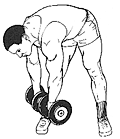 Summer vacation came to an abrupt end for many an elementary school student here in Finland today. It was my first day in the fifth grade… as a teacher. This will be my main occupation this year, but paychecks will also continue to drop in via my freelance activities including lecturing at the university and doing odd translation jobs more often than not related to city planning. The fun thing about teaching fifth graders is that you get to do the whole deal ranging from physical education to chemistry. Powerlifting is not an option in gym class, but the school does have a small gym that I will probably use now and then. Today I steered towards the regular gym.
Summer vacation came to an abrupt end for many an elementary school student here in Finland today. It was my first day in the fifth grade… as a teacher. This will be my main occupation this year, but paychecks will also continue to drop in via my freelance activities including lecturing at the university and doing odd translation jobs more often than not related to city planning. The fun thing about teaching fifth graders is that you get to do the whole deal ranging from physical education to chemistry. Powerlifting is not an option in gym class, but the school does have a small gym that I will probably use now and then. Today I steered towards the regular gym.
Did mini-band assisted GHRs as the main exercise, but did not forget to honor my dual pledge to give the midsection and calves some more time in the limelight.
Also got some inspiration from Mċns’s copy of Bill Pearl’s hefty tome Keys to the Inner Universe, probably the most extensive collection of exercises there is although it gets away with only two versions of the good morning (everybody knows there are in fact 360 variations…). Compound stiff-legged dumbell deadlifts are basically a normal stiff-legged deadlift, but you don’t just bend straight down but also alternately twist down with the dumbells toward the right and left foot. Going down once to the right, middle and left counts as one rep. First tried them directly following the GHRs, but had to abort quickly as I could not bend very far to the right before pain materialized on the left side. Once the back had been warmed up by some more work they felt fine. Bending down sideways with nearly straight legs is one of the more demanding things one can subject a low back to. I figure that if I can get to a point where these are pain-free I’m pretty much good to go. In the meantime, I will start to phase deadlifts and squats back in as going straight down no longer seems to hurt.
Glute ham raise on stability ball: 9,7,5,4 @ doubled mini band assist
Front lunge, alternating: 2x10 @ 30 kg/66 lbs
Standing cable crunch, lat pulley:
15 @ 40 kg/88 lbs
3x10 @ 44 kg/97 lbs
Hanging leg raise: 4x6
Trunk twists with stick kneeling on stability ball: 3x1 minute
Upper body cable turn: 3x30 @ 30 kg/66 lbs
Compound stiff-legged dumbell deadlifts: 3x5 @ 3 kg/7 lbs
Reverse-hyper, done off hyper bench: 30
Seated calf raise: 4x10 @ 70 kg/155 lbs
Total training time: 72 min
August 8, 2004
Balcony Bob descends for rehab
I’m spending each evening out on the balcony nowadays. Not for the view, in fact the façade of the house that blocks our view of the sea is being redone, but for the cool evening breeze that makes the hot weather a little more tolerable. Southern Finland clocked in at 29.4°C/84.9°F today, making this the hottest day of the year so far. I now believe all this balcony sitting is the root cause of the stiff back I’ve been having for the past few days. With seats that tilt backward, our classically cheap balcony chairs aren’t precisely ergonomical, especially if you sit five hours straight in them. Seems like I was too quick to blame the swimming and too slow to bring my office chair out here.
To offset all this sitting, I felt like doing some serious work as I hit the gym. After a rapid 5x15 of hyperextensions, the mother of all pumps had descended on my low back and life was suddenly a lot more brighter. Then came up with the idea of doing the muscle activation by doing small trunk twists with a stick while kneeling on a stability ball; easy, yet rewardingly effective. Besides the usual (don’t have a stability board at the gym yet so none of that), I also resurrected the standing cable crunch in the lat pulley. This introspective entry has a picture of this exercise plus a video clip, with the difference that I did them leaning against the lat pulley frame with a rope handle today (I’d like to believe that looked a little prettier). Among the need to’s is definitively a bigger focus on the midsection again now that I, back permitting, am getting ready to slowly reintroduce squats and deadlifts into my routine.
Hyperextension: 5x15
Trunk twists with stick kneeling on stability ball: 3x1 minute
Upper body cable turn: 3x30 @ 25 kg/55 lbs
Standing cable crunch, lat pulley:
2x10 @ 30 kg/66 lbs
10 @ 40 kg/88 lbs
6 @ 50 kg/111 lbs (too heavy for back)
15 @ 40 kg/88 lbs
Arm and leg extension kneeling on stability ball: 2x14
Walk out with trunk twist (right and left on each rep): 10
Ab hold, one leg on floor: 2x20 seconds
Neural mobilization holding feet: 10
Total training time: 45 minutes
August 7, 2004
Of spines and powerlifting history
To accompany all the heavy spine and back injury talk, here is a very nice animated tutorial from the New Jersey Spine Institute that covers anatomy, various spine conditions, as well as surgical and non-surgical procedures. I saw this mentioned in the Back Pain Support Group forums, which appears to be a good place to take any back concerns.
History buffs and old timers will like the American Powerlifting Evolution site to accompany Sandow and the Golden Age of Iron Men. Laced with pictures, it takes you through the way it used to be 1900-1985, before American powerlifting drowned in the “alphabet soup” of federation acronyms and the equipment race began for real. As a result,
Powerlifting now finds itself in the throes of an absurd paradigm: lifts can no longer be compared between federations without qualifying an embarrassing number of variables. Record setting is curiously suspect at some venues and there are even those who argue that the sport is no longer in existence as originally defined.
I tend to agree with the general party line as presented by this site, but am also the first to agree that the issue is far from black and white. The opposite of unity does not necessarily have to be chaos, but can just as well be freedom of choice. Equipment can add a sizable amount to any lift and can thus easily be labeled an artificial strength boost, but the very same equipment can also help spare the joints. Pick your preference regarding federations and equipment, but with drugs I have no sympathy although I recognize their prevalence in modern powerlifting. For a well-balanced introduction to these issues, see Controversies In Powerlifting by Eddie White.
July 28, 2004
Rehab express
With some mighty glute and ham soreness still lingering from the Sunday workout, I did a slightly abbreviated rehab routine today. Added ab holds, this time with only one leg on the floor, to reinject some static work into the routine. These were hard, but not as hard as the arm and leg extensions kneeling on the stability ball. With these, the ball is prone to make a run for it when you least expect it.
Ball crunch: 30
One-legged balance board standing: 2x1 minutes
Muscle activation standing one-legged on balance board: 2x1 minutes @ 2 kg/4 lbs
One-legged toe touch on balance board: 20
Arm and leg extension kneeling on stability ball: 10
Walk out with trunk twist: 14,10
Ab hold, one leg on floor: 2x20 seconds
Total training time: 30 min
July 21, 2004
Nocturnal rehab
To get some space for today’s amateur acrobatics, I dragged my balance board, stability ball, a 3 kg/7 lbs dumbell and a 10 kg/22 lbs plate down to our large wooden platform originally built for my brother’s table tennis needs. He used to compete on the national level dragging home quite a few trophies at that, but now my dad uses it as a work platform to make wood chips out of branches for his gardening needs. After pushing some of the debris aside, setting up the camera and igniting Motörhead’s live album I Got Mine, bought today for a couple of euros on a sale, I was finally ready to have a virgin go at my new rehab program. It was 11.40pm, but saw none of the bats that sometime swirl around decimating the needlessly large mosquito population.
The one-legged balance board exercises were difficult, but, like yesterday, I managed to do a few reps even standing on the more shaky right leg. I did as many as I could in a row and kept going until I got the needed reps. When it was time for walk outs I changed pace with another metal umlaut band that I also bought cheap, Queensr˙che’s Rage for Order. This was also when dusk started setting in, which come low plate twists made for bad light conditions. At the height of summer you can’t really see any difference between night and day (midnight-2am is your average cloudy afternoon, further north the sun shines), but now the beautiful summer nights are slowly giving way for the pitch black nights of August here at latitude 63° 4′ 0N. Did the neural mobilization exercise out on the quay where the light was better. Had to wrap a plastic bag around my feet to get them to slide easily against the wooden boards.
Even if the nights are getting darker, the water is only getting warmer now that we finally got some summer temperatures here in Finland. It did not take much mental preparation to jump into the 20 degrees Celsius water. A gentle steam danced on the calm water as it met the chilly air.
The video (4.2MB) is here. If it gives you a good laugh, all the better. There is one mistake in the clip; it says the lunges are alternated, but obviously they are done single-legged. Since I’m on dial-up, I’m too lazy to fix it.
One-legged balance board standing: 2x2 minutes
Muscle activation standing one-legged on balance board: 2 minutes @ 3 kg/7 lbs
Balance board lunge: 2x10
One-legged toe touch on balance board: 2x10
Arm and leg extension kneeling on stability ball: 2x10
Walk out with trunk twist: 10?
Side bends on stability ball: 15
Low plate twists: 2x25 @ 10 kg/22 lbs (first set slow, second normal aka fast)
Neural mobilization holding feet: 10
Total training time: Dunno.
July 20, 2004
Fun at the clinic, take three
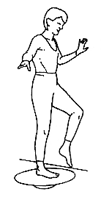 I’ve come to eagerly anticipate the visits to the back clinic and today was no different. The usual preliminaries had me report that I’ve felt some minor morning pain on the right side of the low back when moving between beds this summer, but that otherwise rehab work was fun and progress very tangible.
I’ve come to eagerly anticipate the visits to the back clinic and today was no different. The usual preliminaries had me report that I’ve felt some minor morning pain on the right side of the low back when moving between beds this summer, but that otherwise rehab work was fun and progress very tangible.
High on today’s agenda was to determine whether the muscles on both sides of my lower back where now contracting equally or whether the right side still had problems. The therapist kept her hands on my low back while I was going through the exercises from the previous rehab program and was as pleased as I was; the contraction was now good on both sides, although she noted that I still had less muscle mass on the right side. This, in combination with the occasional lingering pain, proves that I am not quite among the living yet, but she felt that I could soon start working on my squats and deadlifts again. I am to begin with an empty bar and slowly move back up. Hurrah! She also thought my decision to begin doing lunges was sound.
Then for the fun part: new exercises! Out came the balance board again, and she asked me to try standing on it with one leg. After the initial disbelief, I was surprised at how relatively easy it was; yes, I was waving both arms and legs frantically, but this was not Mission Impossible (come to think of it, it wasn’t no Around the World in 80 days either). Quelle surprise when she told me we were going to start doing exercises this way. She handed me a small dumbell and had me do small circles with it going in different directions, again to make the core muscles work harder to keep me from falling off. I lost my footing a couple of times, especially when I tried standing on the right leg with the dumbell in my left hand. She said that this is probably because I am left legged and right handed. Left legged? Never thought of that. I indeed seem to be left legged: this is the leg I use when I need to jump high, this is the leg I’d rather find myself standing on a balance board with, and this is the leg that used to deliver the strongest kicks in my martial arts heyday.
The fun didn’t stop here. Bending over to touch the board with the opposite hand was next, again done standing one-legged. I was not a graceful sight. This was also the first time that the therapist started apologizing for being a bit rusty as she hadn’t done these exercises in a while. As this tune was repeated during later exercises again, I knew that I was indeed being bumped up to the advanced level. I’m starting to think that if therapy is boring it is the wrong kind of therapy; these exercises are among the most fun things I’ve ever done in a gym. Lunges next, where I was to use the free leg to step back into a lunge and then explode back up.
Then it was time for stability ball fun. She got up on a ball straddling it on all fours, and then proceeded to extend one leg back and the opposite arm forward. This was harder than it looked. Walk outs next. Recall that my first rehab program combined them with a straight arm and leg lift, while the second program introduced a twisting component by having me rotate the trunk by lifting one arm out to the side. Now I was to induce rotation by letting the ball slide sideways and rotate in against the movement by lifting the outermost leg. This was a fairly hard thing to do since the ball was not merely unstable but also in motion. It was still something of a shock to find this exercise listed as ‘Olympic level’ in Rick Jemmett’s excellent Spinal Stabilization book.
Fun fun fun. Side bends on the stability ball were not too hard, after a stable enough position was found with feet braced against a wall that is. She wanted me to tell her when the exercise started becoming difficult. This was around the ten rep mark bending towards the right, but much higher for the left, which is consistent with my general injury pattern.
Remember the neural mobilization exercise? After she determined that I had no problems with it anymore, she asked me to try it holding my toes. No pain, so am to do this for reps of ten. Regarding the old exercises, she noted that I am doing them quite explosively (hey, I like to think I am a powerlifter). Nothing wrong with that, but she said that it would be good if I did one set of both the low cable/plate twists and the hyperextensions slowly to stress the muscles differently. Point well taken after I tried.
As we were done with the consultation, she told me that the physician’s referral still allowed for one more visit within a few weeks if I wanted. As far as she is concerned there is no longer any direct need for consultation, but I was welcome to visit the clinic if I wanted to. As I’ve come to view this whole core training thing as a long term project, I told her that I will probably come see her in a few months just for the sake of getting some new ideas to play with. A few hours later, Sanna and I were leaving Helsinki behind on a train bound for the summer cottage and Toffe’s Gym.
